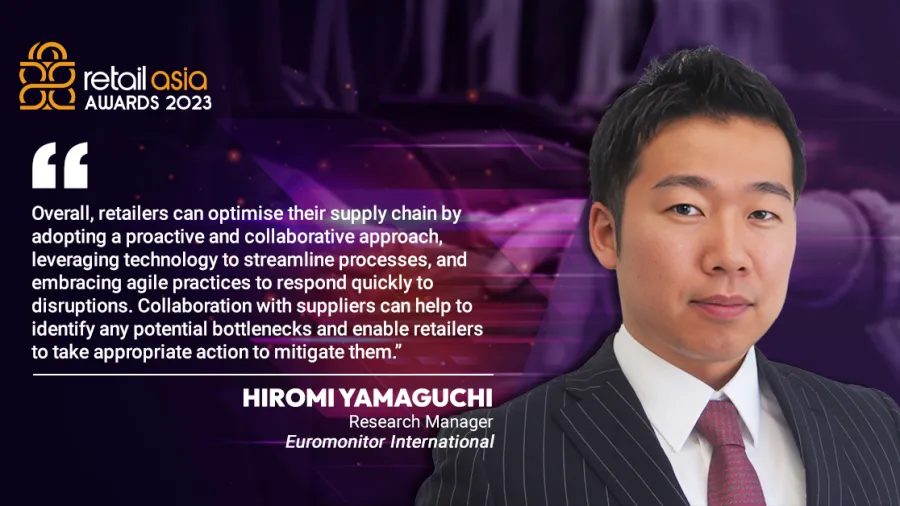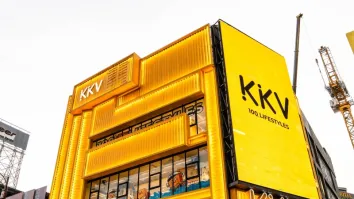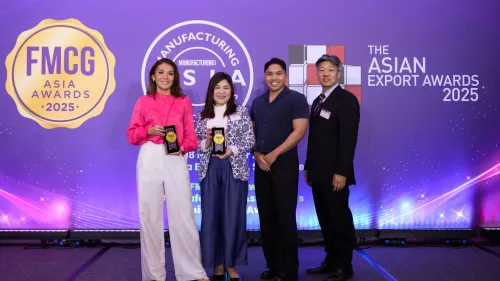
Supplier collaboration helps identify bottlenecks, address sustainability programmes: Euromonitor
This comes as retailers are equipped with an increasing variety of technologies to cater to changing consumer needs.
Hiromi Yamaguchi joined Euromonitor International in 2013, where he currently serves as its Research Manager in Singapore. He leads a team of analysts specialising in consumables, durables and retail market research.
He is responsible for providing actionable data and insights that stimulate growth strategies, go-to-market, and innovation. He is also driving thought leadership pieces and briefings that discuss the industry trends of tomorrow.
Yamaguchi holds a bachelor’s degree in International Business and Chinese Studies at the University of New South Wales in Australia, during which he researched corporate strategies regarding international operations.
Speaking with Retail Asia on his thoughts about the current status of the retail industry, he mentioned that the economic headwinds triggered by global inflation and the pandemic affect price levels both in offline and e-commerce channels to similar extents. This comes despite the acceleration of e-commerce in the region, and the subsequent closure of many brick-and-mortar stores.
Yamaguchi also believes that retailers can optimise their supply chain by adopting a proactive and collaborative approach, leveraging technology to streamline processes, and embracing agile practices to respond quickly to disruptions.
“In the midst of the rising inflation level and the uncertain economic outlook in the region, where a large group of consumers still reside in rural areas, it is also interesting to see how retailers address such consumer base with the aid of improved technologies,” he said.
Yamaguchi provided further insights on the industry’s challenges, adapting to sustainability measures, and how retailers can streamline their supply chain.
Do you think the retail industry should be cautious of the recent economic headwinds brought by global inflation and tightening monetary policies? What can they do to steer clear of its adverse effects?
The world has been in economic uncertainty triggered by the COVID-19 pandemic and the inflation, and Asia is no exception. Such conditions affect price levels across offline and e-commerce to similar extents.
Consumers in the region seek value for money, convenience and a wide assortment afforded by e-commerce. “Shrinkflation” is seen more as a norm for groceries at brick-and-mortar stores to maintain or control the retail prices.
Many growth-stage 3P platforms such as Shopee and Lazada are cutting back on promotions or offers to reach positive cash flow amidst economic headwinds. The outlook for e-commerce will depend on whether e-Commerce operators can continue to provide a compelling retail offer with the above characteristics for consumers to purchase from them.
What do you think are the pressing challenges that the retail industry is currently facing? How can companies drive growth despite these challenges?
A number of brick-and-mortar stores are closing down due to the rise of e-commerce, high operation costs and shifting consumer tastes and preferences.
The rise of e-commerce in the region has accelerated the need for retailers to digitise themselves and seek ways to offer a personalised experience and omnichannel solutions amongst others. For example, Sephora opened an outlet in Singapore where consumers can enjoy cutting-edge make-up technology such as Skincredible that caters to personalised skin concerns. Similarly, e-commerce players are coming into the real world. Shein opened the Shein Tokyo Showroom. The outlet is designed for shoppers to touch and feel the actual products before the purchase using their app and web pages.
How do you think retailers can optimise their supply chain amidst disruptions in the economy? What strategies or technologies can they utilise?
Overall, retailers can optimise their supply chain by adopting a proactive and collaborative approach, leveraging technology to streamline processes, and embracing agile practices to respond quickly to disruptions. Collaboration with suppliers can help to identify any potential bottlenecks and enable retailers to take appropriate action to mitigate them. Diversification of suppliers and manufacturing locations also enables retailers to mitigate the risk of disruptions caused by natural disasters, political instability, or other events.
Automation can also help to streamline the supply chain and reduce the risk of errors. Retailers can automate processes such as order processing, inventory management, and shipping to improve efficiency and reduce costs.
As many industries begin to employ ESG and sustainability programmes, how do you think the retail industry can be compliant?
Retailers can address ESG and sustainability programmes in various ways without disrupting their businesses. Many enter the programmes by collaborating with other businesses. In this region, businesses are quickly catching up with their counterparts in Europe. In Thailand, Tops Supermarket introduced a refill station in collaboration with Unilever. IKEA is another example that is aggressively seeking sustainability opportunities by opening a secondhand business in Thailand, whilst in Singapore the Swedish furniture giant entered a collaboration with Carousell, the local preloved marketplace operator, to launch a reward programme, stimulating the circular economy of furniture. More retailers will be likely to follow in the footsteps of Top Supermarket and IKEA as consumer awareness towards sustainability and ESG efforts is only stronger in the future.
As part of the judges for this year’s Retail Asia Awards, what key qualities or innovations of nominees stand out to you?
Retailers are equipped with an increasingly more variety of technologies to cater to ever-changing consumer needs. Metaverse is a good example of a new technological tool that is available to retailers to communicate with consumers and even offer a new shopping experience to them, despite being at its infant stage.
Equally, in the midst of the rising inflation level and the uncertain economic outlook in the region, where a large group of consumers still reside in rural areas, it is also interesting to see how retailers address such consumer base with the aid of improved technologies.



















 Advertise
Advertise





